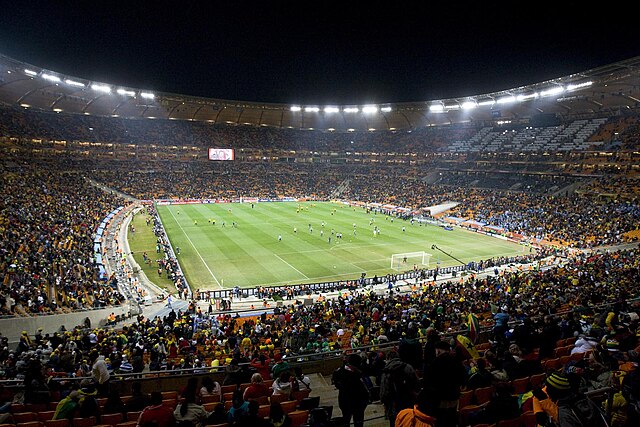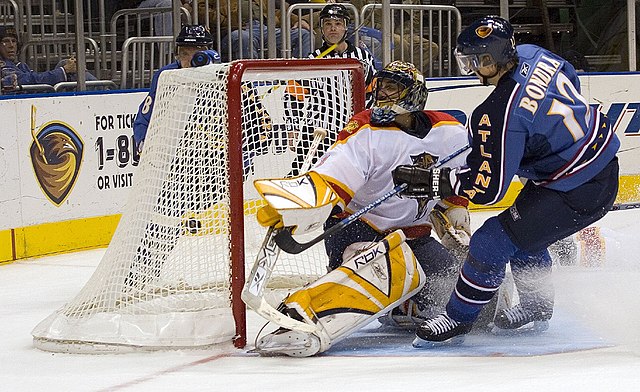Top Qs
Timeline
Chat
Perspective
Western sports
Sports associated with Western culture From Wikipedia, the free encyclopedia
Remove ads
Western sports are sports that are strongly associated with the West.[a] Many modern sports were invented in or standardized by Western countries;[1] in particular, many major sports were invented in the United Kingdom after the Industrial Revolution,[2][3] and later, America invented some major sports such as basketball and baseball.[4]

Western European colonialism and American influence were the initial causes of the spread of Western sports around the world.[5] Later, globalization and the prominent role of Western sports in the Olympic Games helped further grow Western sports.[1][6][7] The most-watched international sporting event is the FIFA World Cup, which showcases the Western sport of football (also known as soccer).[8]
Remove ads
History
Summarize
Perspective

Various minor games and board games were transmitted between the West and the rest of the world in antiquity. Chess originated in India as chaturanga.[9]
Antiquity
The Romans built immense structures such as the amphitheatres to house their festivals of sport. The Romans exhibited a passion for blood sports, such as the infamous Gladiatorial battles that pitted contestants against one another in a fight to the death. The Olympic Games revived many of the sports of classical antiquity—such as Greco-Roman wrestling, discus and javelin.[10] The sport of bullfighting is a traditional spectacle of Spain, Portugal, southern France, and some Latin American countries. It traces its roots to prehistoric bull worship and sacrifice and is often linked to Rome, where many human-versus-animal events were held. Bullfighting spread from Spain to its American colonies, and in the 19th century to France, where it developed into a distinctive form in its own right.[11]
Middle Ages
Jousting and hunting were popular sports in the European Middle Ages, and the aristocratic classes developed passions for leisure activities. A great number of popular global sports were first developed or codified in Europe. The modern game of golf originated in Scotland, where the first written record of golf is James II's banning of the game in 1457, as an unwelcome distraction to learning archery.[12]
Colonial era

Western European countries used sport as a method to increase cultural connections between themselves and their colonies. Colonizers also used sport as a way to keep their soldiers fit in tough environments and to create social changes among colonized peoples; the philosophy of Muscular Christianity was influential in this regard in British colonies, and was also put in practice in Asia by the YMCA.[13] This had an intended effect of causing the decline of traditional sports around the world.[14][15][16][17] On the other hand, colonized peoples often used Western sports as an opportunity to prove themselves by defeating their colonizers in said sports; this contributed to many nascent independence movements.[18]
In South Asia, the influence of and resistance to Western sport also led to the standardization of some traditional Indian games such as kabaddi and introduced organized competitions at statewide and national levels for these games.[19][20][21] In China, the introduction of Western sports resulted in sports being valued more in terms of their competitive aspects,[22][23] in contrast to a native emphasis on sports being used for harmony between people and nature.[24][25][26] In Japan, Western sports were adopted as part of the Meiji era modernization, and were given values in line with the samurai philosophy of Bushido.[27] In Africa, Western sports were imposed with an eye towards the physical threat posed to colonizers by some of the militaristic training activities that Africans had traditionally practiced, and as a way of arguing that Western civilization was more rational and thus superior to African society by emphasizing the fact that Western sports had more elements of standardization and structure, such as yellow cards, fields with chalked-out straight lines, and stopwatches to measure time periods, than traditional African games.[28][29]
Some sports were imported to the West from its colonies; for example, the equestrian game of polo, which was discovered by the British in South Asia, was spread by the British worldwide in a British-standardized form.[30][31] The British also modified some Indian board games to create the modern games of snakes and ladders and ludo.[32]
British sports
Modern team and competitive sports evolved at British publics schools and at the universities of Oxford and Cambridge.[33][34] The Industrial Revolution that began in Great Britain in the 18th century brought increased leisure time, leading to more opportunities for British citizens to participate in athletic activities and also follow spectator sports. These trends continued with the advent of mass media and global communication. The bat and ball sport of cricket, which was first played in England during the 16th century, was exported around the globe via the British Empire. A number of popular modern sports were devised or codified in the United Kingdom during the 19th century and obtained global prominence; these include ping pong, modern tennis, association football, netball and rugby.[35] Many sports which originated in Britain were spread throughout the British Empire during the early modern and Victorian eras, with the British sometimes using these sports to propagate British moral values among their colonial subjects, as well as to assert the superiority of British culture.[36][37][38] The practices involved in the 'sportization' of English pastimes into global sports were also instrumental in shaping the standardization of sports in other parts of the world.[39]
American sports

The United States also developed unique variations of English sports: English migrants took antecedents of baseball to America during the colonial period, and the history of American football can be traced to early versions of rugby football and association football.[40] Many games are known as "football" were being played at colleges and universities in the United States in the first half of the 19th century. American football resulted from several major divergences from rugby, most notably the rule changes instituted by Walter Camp, the "Father of American football".[41] Basketball was invented in 1891 by James Naismith, a Canadian physical education instructor working in Springfield, Massachusetts, in the United States.[42] Volleyball was created in Holyoke, Massachusetts, a city directly north of Springfield, in 1895.[43] In the case of lacrosse, a Native American sport became a professional American sport.[44][45]
The United States pioneered the professionalization of sports; leagues like Major League Baseball, National Football League, and the National Basketball Association are still among the wealthiest leagues in the world.[46][47] Many sports which were professionalized were originally children's games;[48] baseball, for example, began to be taken more seriously when gamblers saw an opportunity to commercialize the sport and started pioneering rigorous statistical reporting for baseball games to create investment opportunities.[49]
America introduced some of its sports to various Asian countries (including American colonies in Asia); this resulted in baseball becoming established in Japan and basketball becoming popular in China.[50] Mark Dyreson has argued that the spread of baseball was modeled in some ways off of Britain's similar stance at the time of exporting British sports throughout its empire to spread British values.[51] Japanese colonization of East Asia helped to spread baseball and other Western sports in the region.[52][53]
Contemporary era

Even as European colonization of the world came to an end after World War 2, Western sports continued to play a prominent role. Western sports became an important part of nation-building and diplomacy for some newly independent countries;[55][56][57] for example, cricket played a significant role in helping India unite its diverse peoples and conduct diplomacy when it faced tensions with its neighbor Pakistan,[58][59] and when Japan was undergoing its post-war occupation, baseball was promoted by Americans as a way of creating reconciliation.[60] Another example of diplomacy was the launching of the Asian Games, which were meant to promote Pan-Asianism.[61]
Western sports also play an important role in the promotion of health and good societal values (such as gender equality) in former colonies,[62] and are generally seen as an important part of the modernization process.[22] The worldwide dominance of Western sports has also resulted in competitions based in Western countries overtaking the popularity of local competitions in other parts of the world,[63] and the further decline of non-Western sports.[64][65][66] Western sports have also grown because of their economic dominance and brand identification among fans.[67][68]
The Olympic Games, though they initially started off with an emphasis on including traditional games from around the world,[69] eventually became a major transmission vector for Western sports, with Western nations dominating in the event.[70] However, some non-Western sports such as judo have over time become part of the Olympics.[71][72]
E-sports have emerged in the modern era; video game adaptations of Western sports have also become popular, such as the FIFA video game series.[73] Some traditional Western games have also been adapted into major professional competitions, as is the case with World Chase Tag for the game of tag.[74]
Remove ads
Major multi-sport events
Summarize
Perspective

Olympic Games

The modern Olympic Games (Olympics; French: Jeux olympiques)[b][75] are the world's preeminent international sporting events. They feature summer and winter sports competitions in which thousands of athletes from around the world participate in a variety of competitions. The Olympic Games, open to both amateur and professional athletes, involves more than 200 teams, each team representing a sovereign state or territory. By default, the Games generally substitute for any world championships during the year in which they take place (however, each class usually maintains its own records).[76] The Olympics are staged every four years. Since 1994, they have alternated between the Summer and Winter Olympics every two years during the four-year Olympiad.[77][78]
Their creation was inspired by the ancient Olympic Games, held in Olympia, Greece, from the 8th century BC to the 4th century AD. Baron Pierre de Coubertin founded the International Olympic Committee (IOC) in 1894, leading to the first modern Games in Athens in 1896. The IOC is the governing body of the Olympic Movement, which encompasses all entities and individuals involved in the Olympic Games. The Olympic Charter defines their structure and authority.Commonwealth Games


Remove ads
List of sports
Athletics

Bat-and ball games

Baseball
Baseball is a bat-and-ball sport played between two teams of nine players each, taking turns batting and fielding. The game occurs over the course of several plays, with each play beginning when a player on the fielding team, called the pitcher, throws a ball that a player on the batting team, called the batter, tries to hit with a bat. The objective of the offensive team (batting team) is to hit the ball into the field of play, away from the other team's players, allowing its players to run the bases, having them advance counter-clockwise around four bases to score what are called "runs". The objective of the defensive team (referred to as the fielding team) is to prevent batters from becoming runners, and to prevent runners advancing around the bases. A run is scored when a runner legally advances around the bases in order and touches home plate (the place where the player started as a batter).
Cricket
Cricket is a bat-and-ball game that is played between two teams of eleven players on a field, at the centre of which is a pitch with a wicket at each end, each comprising two bails (small sticks) balanced on three stumps. Two players from the batting team, the striker and nonstriker, stand in front of either wicket holding bats, while one player from the fielding team, the bowler, bowls the ball toward the striker's wicket from the opposite end of the pitch. The striker's goal is to hit the bowled ball with the bat and then switch places with the nonstriker, with the batting team scoring one run for each of these swaps. Runs are also scored when the ball reaches the boundary of the field or when the ball is bowled illegally.
Goal sports

Basketball
Basketball is a team sport in which two teams, most commonly of five players each, opposing one another on a rectangular court, compete with the primary objective of shooting a basketball (approximately 9.4 inches (24 cm) in diameter) through the defender's hoop (a basket 18 inches (46 cm) in diameter mounted 10 feet (3.05 m) high to a backboard at each end of the court), while preventing the opposing team from shooting through their own hoop. A field goal is worth two points, unless made from behind the three-point line, when it is worth three. After a foul, timed play stops and the player fouled or designated to shoot a technical foul is given one, two or three one-point free throws. The team with the most points at the end of the game wins, but if regulation play expires with the score tied, an additional period of play (overtime) is mandated. However, if the additional period still results in a tied score, yet another additional period is mandated. This goes on until the score is not tied anymore.
Football
Football is a family of team sports that involve, to varying degrees, kicking a ball to score a goal. Unqualified, the word football generally means the form of football that is the most popular where the word is used. Sports commonly called football include association football (known as soccer in Australia, Canada, South Africa, the United States, and sometimes in Ireland and New Zealand); Australian rules football; Gaelic football; gridiron football (specifically American football, arena football, or Canadian football); International rules football; rugby league football; and rugby union football. These various forms of football share, to varying degrees, common origins and are known as "football codes".
Hockey
Hockey is a family of stick sports where two opposing teams use hockey sticks to propel a ball or disk into a goal. There are many types of hockey, and the individual sports vary in rules, numbers of players, apparel, and playing surface. Hockey includes both summer and winter variations that may be played on an outdoor field, sheet of ice, or an indoor gymnasium. Some forms of hockey require skates, either inline, roller or ice, while others do not. The various games are usually distinguished by proceeding the word hockey with a qualifier, as in field hockey, ice hockey, roller hockey, rink hockey, or floor hockey. In each of these sports, two teams play against each other by trying to manoeuvre the object of play, either a type of ball or a disk (such as a puck), into the opponent's goal using a hockey stick. Two notable exceptions use a straight stick and an open disk (still referred to as a puck) with a hole in the center instead. The first case is a style of floor hockey whose rules were codified in 1936 during the Great Depression by Canada's Sam Jacks. The second case involves a variant which was later modified in roughly the 1970s to make a related game that would be considered suitable for inclusion as a team sport in the newly emerging Special Olympics. The floor game of gym ringette, though related to floor hockey, is not a true variant because it was designed in the 1990s and modelled on the Canadian ice skating team sport of ringette, which was invented in Canada in 1963. Ringette was also invented by Sam Jacks, the same Canadian who codified the rules for the open disk style of floor hockey in 1936.
Certain sports which share general characteristics with the forms of hockey, but are not generally referred to as hockey include lacrosse, hurling, camogie, and shinty.Golf
Racket sports
Racket sports (or racquet sports) are games in which players use a racket or paddle to hit a ball or other object. A racket has a handled frame with an open hoop that supports a network of tightly stretched strings. A paddle, sometimes called a bat, has a solid face rather than a network of strings, but may be perforated with a pattern of holes, or be covered with a textured surface.
Remove ads
See also
References
Notes
Wikiwand - on
Seamless Wikipedia browsing. On steroids.
Remove ads

